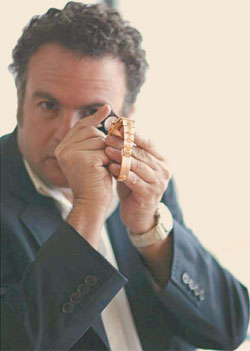Internet revolutionises vintage watch collectors’ world

Roula Khalaf, Editor of the FT, selects her favourite stories in this weekly newsletter.
Vintage watch collecting was once the preserve of well-informed enthusiasts. But that has all changed thanks to specialist websites and a handful of international dealers.
“[The internet] is probably the best thing that happened to the watch business,” says Matthew Bain, one of American’s leading vintage watch dealers, who now sells the majority of his watches online.
“It has brought the watch world closer together, and made it a lot more knowledgeable, and it’s created more collectors.”
Two types of collectors are drawn to buying vintage watches online, and both are growing in numbers in the market, Mr Bain says. Some are shoppers in markets that are comparatively new for watch collecting, such as China, South America, and even secondary and tertiary cities in the US, that benefit from the ease the internet affords.
Others are young collectors, often more familiar with a mouse than an auction room hammer. Stephen Pulvirent, associate editor at Hodinkee, a website dedicated to vintage watches, says: “Maybe, 20 years ago, vintage watch collecting was something reserved for 70-year-old men in their country houses who were going to auctions and reading all the catalogues.
“It was kind of a club and you had to be an insider to participate. Dealers are now understanding that there are customers in their early 20s and 30s who want to buy something cool and of substance, who are using things such as Facebook, Tumblr, Instagram and the internet to find things.”
Selling on the internet and through social media has made it easy for dealers to serve customers from around the world, no matter where those dealers are.
Mr Bain, for example, lives and works in Miami. Another top dealer, Tom Bolt, is based in Mayfair in London. Rolex specialist Eric Ku is based in Los Angeles, while another American vintage Rolex seller, Andrew Shear, works in New York. Andrea Foffi and Marlon DeSimone are both well-respected dealers located in Italy, a centre of vintage watch collecting since the 1980s.
While these dealers operate their own websites, some sell to a wider audience through auction houses such as eBay.
Increasingly, Twitter and Instagram are popular (and profitable) avenues, offering a more discreet way to sell to obsessive collectors by simply posting a photograph of a timepiece without a price or detailed description.
As Mr. Bain explains, “There are groups of us on social media who all know one another; we say: ‘Look what I found today’. We do business and no one knows we’re doing business. Instagram has become huge in the past year and a half in the vintage watch community.”
Leaving prices unlisted is a sales strategy that is not reserved for social media.
“You see more and more important dealers who don’t give prices on their website, especially for the vintage pieces,” explains Julien Schaerer, managing director of Antiquorum, an auction house specialising in watches.
“They just say ‘upon request’, because it allows them to ask for the price they feel is right, and also adjust prices quickly according to what the market is doing.”
Auction houses are also taking note of how the internet can be incorporated into their business in new ways. Last October, Christie’s held its first online-only watch auction, including collectables such as a 1970s stainless steel Patek Philippe Nautilus.
The company is adding a dedicated watch sales area, Watch Time, to its website in June. The new venture will offer timepieces to buy (rather than for auction), which is also how Sotheby’s presented 26 specially curated watches in November in a week-long digital pop-up shop.
Although there are plenty of important watches available online with no cap to what serious collectors will spend, the “sweet spot” price in terms of buying on the internet is, according to Tom Bolt, £2,000-£15,000.
Some general luxury resale websites are having success with the addition of watches at the lower end of that price range. On The RealReal site, for example, vintage timepieces, which it began carrying in 2012, now account for more than a quarter of the retailer’s jewellery business.
Sellers are finding ingenious ways for potential customers to inspect items online. At Sotheby’s, for example, e-catalogues offer magnification, and some pieces are photographed at enough angles to offer a 360-degree view, making details easier to see on a computer screen than in person.
Watch forums, such as those on Timezone.com, allow collectors to swap information and sometimes buy and sell directly with one another.
Yet, no matter how easy the internet can make pre-purchase research, buyers still need to be cautious and discerning. John Reardon, international co-head of watches at Christie’s, says: “It comes down the same things as a bricks-and-mortar auction house: trust, value, and expertise.
“People are now comfortable with the medium of buying online, and, combined with a trusted source, that client has a level of comfort that it’s safe to buy.”
Comments